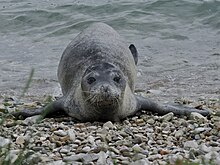
A | B | C | D | E | F | G | H | CH | I | J | K | L | M | N | O | P | Q | R | S | T | U | V | W | X | Y | Z | 0 | 1 | 2 | 3 | 4 | 5 | 6 | 7 | 8 | 9
| Monk seals | |
|---|---|

| |

| |
| Hawaiian monk seal (top) and Mediterranean monk seal (bottom) | |
| Scientific classification | |
| Domain: | Eukaryota |
| Kingdom: | Animalia |
| Phylum: | Chordata |
| Class: | Mammalia |
| Order: | Carnivora |
| Clade: | Pinnipedia |
| Family: | Phocidae |
| Subfamily: | Monachinae |
| Tribe: | Monachini Scheffer, 1958 |
| Species | |
|
Monachus monachus | |

| |
| Hawaiian monk seal range | |

| |
| Mediterranean monk seal range | |
Monk seals are earless seals of the tribe Monachini. They are the only earless seals found in tropical climates. The two genera of monk seals, Monachus and Neomonachus, comprise three species: the Mediterranean monk seal, Monachus monachus; the Hawaiian monk seal, Neomonachus schauinslandi; and the Caribbean monk seal, Neomonachus tropicalis, which became extinct in the 20th century. The two surviving species are now rare and in imminent danger of extinction. All three monk seal species were classified in genus Monachus until 2014, when the Caribbean and Hawaiian species were placed into a new genus, Neomonachus.
Monk seals have a slender body and are agile. They have a broad, flat snout with nostrils on the top. Monk seals are polygynous, and group together in harems. They feed mainly on bony fish and cephalopods, but they are opportunistic. The skin is covered in small hairs, which are generally black in males and brown or dark gray in females. Monk seals are found in the Hawaiian archipelago, certain areas in the east Atlantic and Mediterranean Sea (such as Cabo Blanco and Gyaros island), and formerly in the tropical areas of the west Atlantic Ocean.
All species experienced overhunting by sealers. The Hawaiian monk seal experienced population drops in the 19th century and during World War II, and the Caribbean monk seal was exploited since the 1500s until the 1850s, when populations were too low to hunt commercially. The Mediterranean monk seal has experienced both commercial and illegal hunting since the Middle Ages and has always been threatened with eradication by fishermen. As of 2022, it is estimated and agreed upon that not more than 600-700 Mediterranean monk seals remain, concentrated primarily along the coasts of Turkey, Cyprus, and Greece. The Hawaiian monk seal appears to be faring somewhat better; the 2021 monk seal population count by the National Oceanic and Atmospheric Association (NOAA) numbered 1,570 animals, an encouraging increase from 1,453 seals in 2019. This marked the first time the Hawaiian monk seal's population exceeded 1,500 in 20 years; their numbers have been recorded and observed to increase approximately 2% each year from 2013-2021.[1] Some of this successful growth is undoubtedly due to numerous rescue-and-release operations and the relocating of weaned pups to quieter beaches (with lower numbers of predatory sharks and less human interactions), enabling more seals to mature naturally and safely.[2]
Etymology
The name "monk seal" (German Münchs-Robbe) was suggested by naturalist Johann Hermann, who claimed that the seal was popularly known as moine (French for "monk") in Marseilles, and speculated that the seal looks from behind like a monk wearing a cape and hood.[3]
